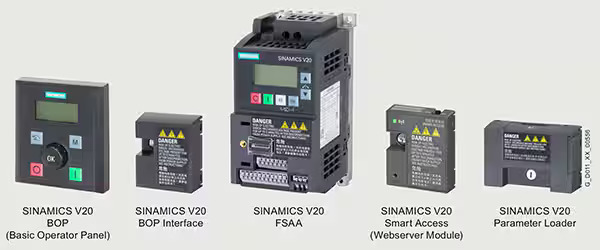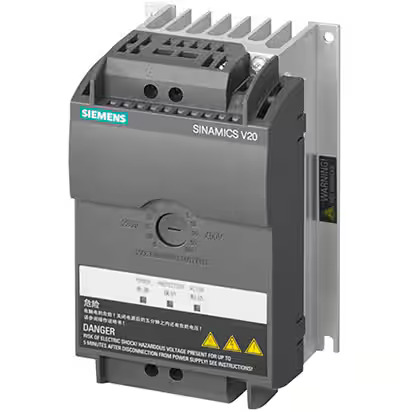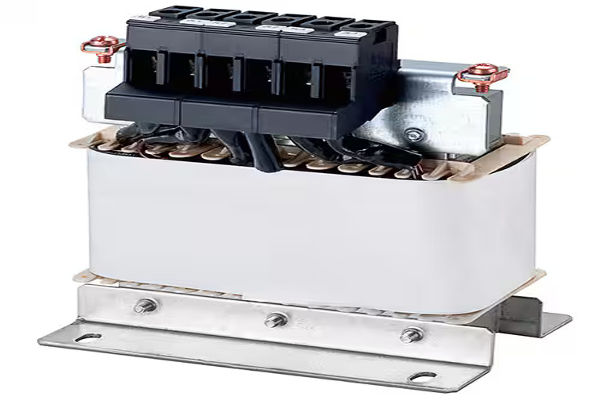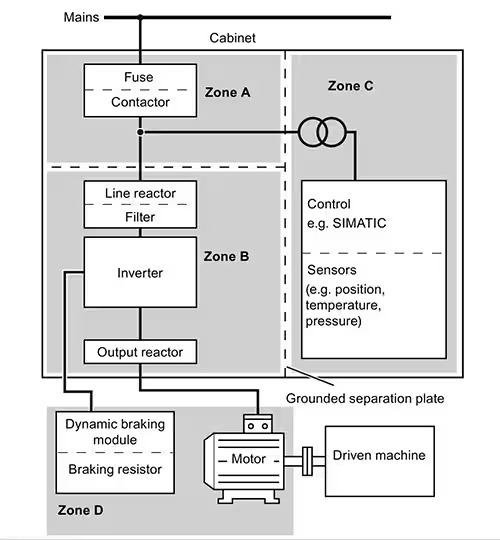SINAMICS V20 drives are designed to be controlled by a SINAMICS S7-1200 or S7-1500 controller, like model 6ES75173FP000AB0, through the RS485 interface and using the Universal Serial Interface (USS) protocol.
Single-axis VSDs (variable speed drives) are essential in industrial applications like pumps, fans, compressors, conveyors, and processing operations such as mills and mixers.
These applications have simple motion sequences and require efficient Single-Axis VSDs to support quick and economical implementation of basic drive functions with short commissioning times.
Single-axis VSDs can require a variety of control functions, including scalar volts per Hertz (V/f), programmable V/f multi-point, V²/f that automatically adapts the flux to save energy, and flux current control (FCC) that automatically adapts the drive output to the load.
Cost-effective deployment and integration are key for industrial systems and benefit from features like:
- Preconfigured application selection
- Compact size
- Preset communication parameters
- Efficient transfer of parameter settings to multiple units
- Wireless commissioning, operation, and diagnostics
- Connection and application macros to simplify I/O wiring and configuration
This article presents a family of rugged and energy-efficient single-axis VFDs from Siemens designed to simplify the installation. It also reviews several integrated functions, looks at basic system accessories and a variety of more specialized and advanced add-on modules, and integration suggestions using Siemens controllers.
It closes by reviewing some considerations for integrating these VFDs into EMI-compliant control cabinets and industrial motion systems.
Digitizing motor control brings multiple benefits to industrial single-axis motion systems. Replacing simple mechanical controls with a Single-Axis VSD enables the system to respond to situations of partial load operation immediately and can reduce power consumption by 50% or more.
Variable speed operation can also minimize wear and tear on motors and mechanical components, reducing maintenance needs and improving availability.
The SINAMICS V20 platform from Siemens is available in nine frame sizes, and it covers a power range of 0.12 kW to 30 kW (0.16 hp to 40 hp) (Figure 1). Exemplary SINAMICS V20 VFDs include the 0.12 kW 6SL3210-5BB11-2UV1 up to 3 kW, the 6SL3210-5BB23-0UV1 single-phase 230 VAC input models, and the 0.37 kW 6SL3210-5BE32-2UV0 up to 30 kW three-phase 480 VAC models.

Efficiency is a major benefit of using SINAMICS V20 drives. They are compact and make efficient use of space; they support rapid installation and commissioning, making efficient use of time and money, and they are energy efficient, supporting a greener planet.
Some of the many features include:
- Economical operation supported by multiple control modes including V/f, V²/f, FCC, and V/f multi-point
- Energy savings can be enhanced using ECO mode for V/f, V²/f, and a hibernation mode
- Energy savings can be monitored without external power measurement equipment and displayed in kWh, CO2, or currency
- Single-phase or 3-phase mains power
- Single phase 200 to 240 VAC (–10% / +10%) can also be connected to two phases of a 3-phase 120 / 240 VAC mains
- Three-phase 380 to 480 VAC (–15% / +10%)
- Preconfigured application macros reduce commissioning time
- Preset communication parameters speed commissioning using standard libraries and connection macros
- Automatic adaptation to unstable mains voltages ensures stable operation, prevents interruptions, and helps deliver higher productivity
- Overload capability up to 150% for 60 s within a cycle time of 300 s
- Maximum output voltage is 100% of the input voltage
- Parameter loading without power supply allows quick configuration of multiple units
- Commissioning with mobile device or laptop with Smart Access web server
- Integrated application and connection macros
Integrated functions
SINAMICS V20 drives have several integrated functions that speed deployment and simplify integration, like a proportional-integral-derivative (PID) controller for process control tasks, integrated brake chopper on the largest 2 frame sizes, and a DC coupling function that enables two equal-sized drives to work in tandem for increased energy savings.
The PID controller can be used in simple process tasks like controlling pressures, levels, or flow rates relative to a set point.
The PID function includes autotuning for optimal operation and can support motor staging operation. Motor staging allows the control of up to 2 additional staged (cascaded) motors. In this case, the system consists of the primary motor controlled by the inverter and two additional motors controlled using contactors or starters controlled by digital outputs on the inverter.
FSD and FSE frame sizes have an integrated braking chopper; for other frame sizes, an external brake module is available (see below). The motor can be electrically or mechanically braked.
- Electrical brake options
- DC braking is applied to the stator winding, resulting in significant braking torque. While not suitable for holding suspended loads, the current can hold the shaft stationary once rotation has stopped.
- Compound braking superimposes DC braking on regenerative braking, where the inverter regenerates energy into the DC-link supply during braking.
- Dynamic braking converts regenerative energy into heat. Implementation of dynamic braking requires an external braking resistor to dissipate the energy.
- A mechanical motor holding the brake can be controlled by internal logic to prevent the motor from turning when the inverter is switched off.
SINAMICS V20 drives also include a DC coupling function that enables two equally sized inverters to be electrically coupled using their DC-link connections. When applicable, DC coupling can reduce energy costs by allowing one inverter to use regenerative energy drawn from the other inverter.
The inverters can share a single dynamic braking system, reducing installation costs. In some cases, DC coupling can eliminate the need for a dynamic braking module and a dynamic braking resistor.
Basic system accessories
In addition to integrated functions, the utility of SIMAMICS V20 inverters can be enhanced by adding a few system accessories like a basic operator panel (BOP) and BOP interface, a smart access module, and a parameter loader (Figure 2):
- The SIMAMICS V20 has an integrated control panel, but some applications can benefit by adding a BOP for remote control of the unit. The BOP is designed for distributed mounting and has a UL Type 1 enclosure rating.
- The BOP is connected to the SINAMICS V20 using a specialized BOP Interface module that plugs into the expansion port on the inverter and has an RS232 interface for connecting to the BOP.
- The Smart Access module has a built in web server that simplifies commissioning and operating of the SINAMICS V20 using a smartphone, laptop, or tablet.Functions supported by this module include:
- Commissioning wizard to speed commissioning
- Parameter setting and saving, or restoration of factory settings
- Motor testing
- Monitoring operational data
- Performing system diagnostic checks
- The Parameter Loader can upload up to 100 parameter sets to the SINAMICS V20 or download parameter sets from the unit. The battery powered parameter loader can be used without powering up the drive.

The 0.16 HP FSAA SINAMICS V20 shown with four common expansion modules. (Image source: Siemens)
More accessories
Line filters can be added when needed. To meet EN 61800-3 Category C2 Radiated and Conducted Emission, external EMC filters are required for the SINAMICS V20 inverters (400 V filtered and unfiltered models, as well as 230 V unfiltered models).
For example, model 6SL32030BE177BA0 is designed for use with FSA frame size 400 V inverters.
Line reactors are available to smooth voltage peaks or bridge commutating dips. These reactors also reduce the effects of harmonics on the line supply and the converter.
Braking can be implemented using the 6SL32012AD208VA0 braking module (Figure 3) with frame sizes FSAA to FSC. FSD and FSE frame sizes have an integrated braking chopper and don’t require an external module.
In all cases, better braking performance and improved deceleration can be realized by adding an external braking resistor like model 6SE64004BC050AA0 to dissipate the regenerative energy produced by the motor.

Applications needing inputs or outputs can add the SINAMICS V20 I/O Extension module (Figure 4).
The module mounts directly on 400 V range of inverters and provides two digital inputs and two digital relay outputs. For example, the I/O extension module can be used in multi-pump control applications, enabling up to four pumps to be controlled with a single SIMAMICS V20 drive.
The module is also useful when multiple fans or compressors must be controlled. It has connections on the front and rear and can be combined with other accessories like the BOP interface and smart access modules. However, it can’t be used simultaneously as the parameter loader module.

Output reactors, like model 6SL3202-0AE16-1CA0 for FSA frame size, can reduce the voltage stress on the motor windings (Figure 5). These output reactors also reduce the capacitive charging and discharging currents that can stress the inverter when long motor cables are used.
Integration into larger systems
SINAMICS V20 drives are designed to be controlled by a SINAMICS S7-1200 or S7-1500 controller, like model 6ES75173FP000AB0, through the RS485 interface and using the Universal Serial Interface (USS) protocol. Sample projects demonstrating how to configure and program these controllers with a SINAMICS V20 are available. USS is the default setting, but a SINAMICS V20 can also use MODBUS RTU protocol.
One master controller can connect to a maximum of 31 VFDs.
Putting it all together
Assembling the components detailed above into a complete system can be challenging, especially if EMC compliance is an important consideration. Isolating potential sources of interference is usually the fastest and most cost-effective approach.
It can be achieved by organizing the control cabinet and the rest of the system into a series of four isolated zones, as shown in Figure 6. Considerations when implementing the isolation zones include:
- Electromagnetic decoupling of the zones can be achieved using grounded separation plates or separate metal housings.
- The SINAMICS V20 is in Zone B, and a SIMATIC S7-1200 or S7-1500 controller is in Zone C.
- For improved EMC performance, filters, and coupling modules can be added at the interfaces of the zones.
- Connecting cables between the zones must be separated to prevent EMC coupling and must not be in the same cable channel or harness.
- Communication network and signal cables like RS485 entering or leaving the cabinet must be shielded.

Electromagnetically decoupled zones can enhance the EMC performance of SINAMICS V20 installations. (Image source: Siemens)

About The Author:
Jeff has been writing about power electronics, electronic components, and other technology topics for over 30 years. He started writing about power electronics as a Senior Editor at EETimes. He subsequently founded Powertechniques, a power electronics design magazine, and later founded Darnell Group, a global power electronics research and publishing firm. Among its activities, Darnell Group published PowerPulse.net, which provided daily news for the global power electronics engineering community. He is the author of a switch-mode power supply text book, titled “Power Supplies,” published by the Reston division of Prentice Hall.
Jeff also co-founded Jeta Power Systems, a maker of high-wattage switching power supplies, which was acquired by Computer Products. Jeff is also an inventor, having his name is on 17 U.S. patents in the fields of thermal energy harvesting and optical metamaterials and is an industry source and frequent speaker on global trends in power electronics. He has a Masters Degree in Quantitative Methods and Mathematics from the University of California.
ARTICLE SOURCE: https://www.digikey.in/


You must be logged in to post a comment.